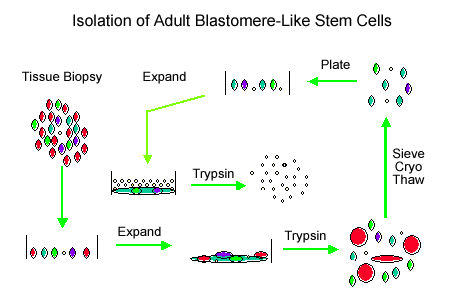Blastomere-Like Stem Cells
Moraga's scientific founders have isolated from adult tissues a patented (pending), primordial stem cell with embryonic-like characteristics. These blastomere-like stem cells are derived from non-embryonic cells and tissues of postnatal animals and humans. It is capable of self-renewal. It can differentiate into all somatic cells of embryonic orgin, germ cells, and possibly placenta and ova. The Company's adult-derived BLSCs can be induced, in a uni-directional fashion, to form pluripotent epiblastic-like stem cells; ectodermal germ layer lineage stem cells, mesodermal germ layer lineage stem cells, or endodermal germ layer lineage stem cells; multipotent progenitor cells, tripotent progenitor cells, bipotent progenitor cells, unipotent progenitor cells, and differentiated cells. Additionally, these BLSCs can be isolated from the connective tissues of postnatal animals, including humans. From fresh tissue isolates these blastomere-like cells are less than 2 microns in size. They do not express the CD10, CD13, CD56, CD90, CD106, CD123, CD166, MHC Class-I, or HLA DR-II cell surface markers while displaying a normal karyotype.
These BLSCs remain quiescent in serum-free defined medium in the absence of differentiation inhibitory agents, such as leukemia inhibitory factor or anti-differentiation factor. When they are implanted into animals, these uncommitted stem cells derived from adults do not form cancerous tissues. Rather, they either remain quiescent after implantation or incorporate into all the tissues undergoing repair. These stem cells can also be stimulated to proliferate by growth factors. When stimulated, these stem cells undergo self-renewal as long as they remain lineage-uncommitted.
Moraga's stem cells have the potential to generate all tissues of the conceptus including, but not limited to, the embryonic/fetal portion of the placenta, germ cells and all the somatic cells of the embryo/fetus from all three germ layer lineages. For example, an adult-derived blastomere-like human stem cell line and an adult-derived blastomere-like rat clone after more than 300 doublings were both induced to form spermatogonia and somatic cells of the embryo. The somatic cells included pluripotent epiblastic-like stem cells and germ layer lineage stem cells, both of which are telomerase positive, and lineage-committed progenitor cells.
After extended exposure to dexamethasone, adult-derived blastomere-like stem cells differentiated into more than 50 discrete cell types. The induced cell types exhibited characteristic morphological and phenotypic expression markers for spermatogonia, pluripotent epiblastic-like stem cells, and germ layer lineage stem cells derived from the mesoderm, ectoderm, and endoderm with their respective differentiated cell types. This induced unidirectional lineage-commitment process necessitates the use of either general induction agents or those that cause the cell to differentiate into specific lineages shown in the below diagram.

Due to their unique ability to self-renew, the Company believes it can provide an unlimited supply of these BLSCs for the life science markets. Most stem cell researchers, whether working with adult or embryonic stem cells, are faced with the challenge of maintaining a homogenous population of these cells during their propagation in an artificial cell culture environment. Embryonic stem cells are notorious for their propensity to spontaneously differentiate into progenitor cells during their cultivation. Moraga's scientific founders have solved some of these technical issues regarding stem cell cultivation through the development of its proprietary serum-free defined cell culture media. The Company's proprietary culture media provide for the proliferating BLSCs to maintain a homogenous population of undifferentiated cells. The below illustration demonstrates how homogeneity of a stem cell population results from symmetrical cell division in which identical daughter cells are produced during mitosis.
Conversely, asymmetrical cell division will result in two different daughter cells---an undifferentiated blastomere-like stem cell and a progenitor cell becoming committed to becoming a specific tissue lineage cell. Without the appropriate culture media and tissue culture environment, stem cells favor the asymmetrical cell division pathway. After several passages of the cell cultures, committed progenitors will make up a majority of the cells being cultivated if asymmetrical cell division is not inhibited.

Isolating, purifying and propagating Moraga's BLSCs is a simple procedure when using specialized reagents developed by the Company. The cells can be isolated from a variety of human tissues. The BLSCs in terms of phenotype and functionality is the same irrespective of whether the cells are isolated from either fat or muscle tissues. The protocol for isolating these cells is illustrated in the below diagram.

The ability to propagate the BLSCs and maintain symmetrical cell division will allow the Company to scale up the production of these cells to a commercial manufacturing process. The cells can also be frozen without a loss of functionality. This storage process will allow the Company to develop a diverse stem cell library of human BLSCs derived from patients who are genotyped and as well as stem cells from patients having different chronic disease.
Very recently, the Company has developed a novel process in which millions of BLSCs have been isolated from fresh adult tissues. With its proprietary serum-free defined media, the isolation procedure does not require process described above. This breakthrough enrichment process is simple and very cost-effective. This new process provides the Company a near-term opportunity into commercializing both autologous cell-based therapies and banking stem cells and differentiated tissues. This proprietary process is being patented.
